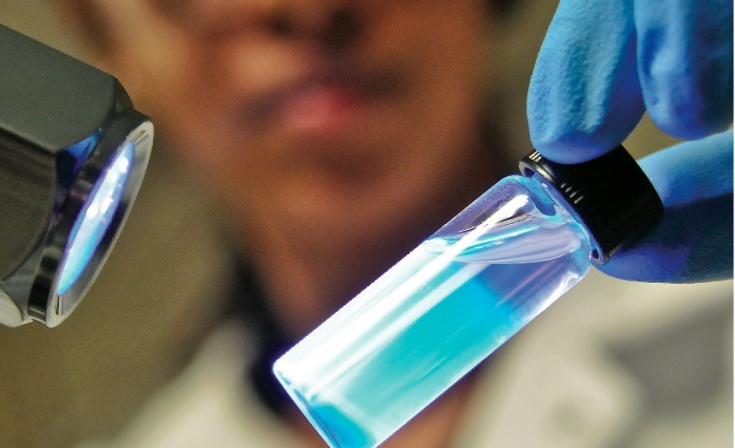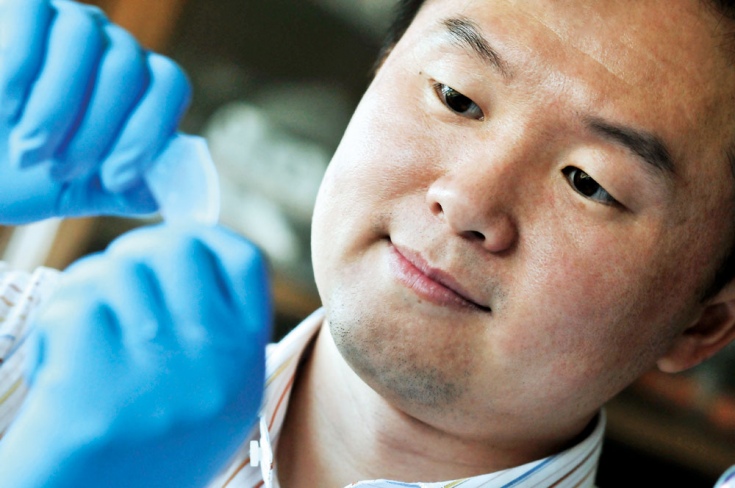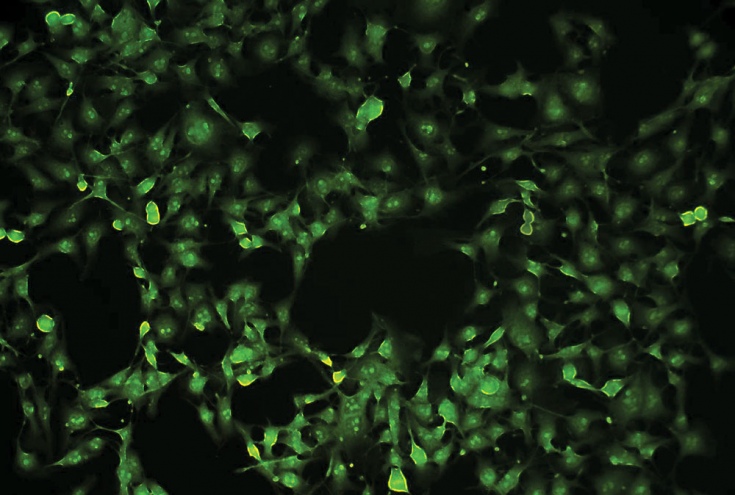Quantum Leap
A fluorescent material that uses naturally occurring building blocks could help detect cancer in early stages and deliver drugs to combat the disease.

Glowing Results
Bioengineering our future
Jian Yang’s latest discovery is getting glowing reviews. That’s because his latest discovery, well, glows. The bioengineering assistant professor has developed a material that’s fluorescent, biodegradable, and safe to implant in the body. Bill Carroll, UT Arlington engineering dean, calls Dr. Yang’s work “revolutionary… in cancer therapy or for imaging,” not to mention what it could do for biosensing, immunology, drug delivery, and tissue engineering.
It’s not just Yang’s colleagues at UT Arlington who have taken note. His research is funded in part by the National Institutes of Health/National Institute of Biomedical Imaging and Bioengineering. It was recently reported in the prestigious Proceedings of the National Academy of Sciences. Two months later, the influential American Chemical Society called the work “Noteworthy Chemistry,” a title not bestowed lightly, nor often bestowed on engineers.
Yang’s material is the first of its kind that’s nontoxic (can be used in biomedicine), biodegradable (no long– term toxicity concerns) and has natural fluorescence (can be used as an imaging instrument). Noteworthy, indeed.
It’s an aliphatic biodegradable photoluminescent polymer, or BPLP. It comes from the laboratory, not nature, but to ensure its usefulness in biomedicine, Yang used naturally occurring building blocks, among them citric acid, octanediol and nearly two dozen amino acids.
“With our polymer, you can do many things,” he says. “You can use it as an implant. You can make our polymer into a bone-repairing template. You can use it for detection, tracking, and sensing applications. And since it’s degradable, it’s not a permanent implant. It will help the body heal; then when you don’t need it anymore, it’s just gone.”
Say you want to eradicate the No. 1 killer in the United States: heart disease. While bypass surgery can be lifesaving, it’s highly invasive and often inefficient. So instead of punching through a clot with a permanent metal stent and then repeating the procedure years later as clots accumulate on the stent, doctors may be able to use Yang’s BPLP to make entirely new blood vessels for their patients.
Or perhaps a patient needs an organ transplant. Ratherthan waiting years for a donor and then facing potential rejection, maybe doctors will use BPLP to grow organ tissue using the patient’s own stem cells. No waiting. No rejection.
And this is just a blip of what BPLP can do.
YOU SAY YOU WANT A REVOLUTION?
The leading edge of treating cancer is nanoparticles that transport drugs directly to cancerous cells, like tiny Trojan horses. It’s an effective treatment with few side effects.
For Yang, it’s a starting point.
Because his BPLP glows brightly with an intrinsic fluorescence, using the polymer as a coating for drug-delivery nanoparticles would let doctors trace the path of the medicine within the body, making sure that it reaches the target. Further, doctors could monitor how scaffolding inside the body degrades and how tissue regenerates. Yang believes that his polymer gives physicians “a universal way of knowing” what’s going on inside their patients’ bodies.
A fluorescent material that uses naturally occurring building blocks could help detect cancer in early stages and deliver drugs to combat the disease.

This also could help in the early detection of cancer, which is sometimes extremely difficult given the size and location of certain cancers. For example, early gastric cancers are not detectable using the current white-light endoscopic diagnosis.
“One challenge in the surgical removal of cancer is that doctors can find the big tumors, but they cannot find the small cancerous area as easily,” Yang says. “If you don’t remove those small cancer cell clusters, then you leave some cancer cells behind in the body. They can proliferate and grow into even bigger tumors in the future.”
There are so many applications in so many fields—not just biomedical. I’m trying to develop biodegradable polymeric quantum dots. This would be a paradigm shift.
—Jian Yang
In the body, a light shines on the BPLP and a bright glow results, ranging from blue to near infrared. Medical imaging machines then use this glow to produce a picture of the inside of the body and reveal things like previously unseen cancer cells.
Thanks to Yang’s polymer, the same nanoparticles that deliver drugs to the cancer can also diagnose new cancers. He isn’t the first person to think of this, but he is the first to figure out how to make such intrinsically fluorescent implant polymers do both jobs. Previous researchers tried using organic fluorescent dyes, which are widely available but can be toxic. They’re also chemically unstable, so their signal gets gradually weaker.
Researchers turned to quantum dots, which are nanoparticles used in the fabrication of transistors, solar cells, LEDs, and lasers. Their fluorescence is stable and super bight. But quantum dots are made of metal, so they can poison the body as they decompose. Organic dyes and quantum dots are merely imaging agents and can’t be used as implant materials such as drug delivery carriers or tissue-repairing templates.
Yang’s polymer forgoes the dye and the quantum dots. “The material itself is fluorescent, and this is unique,” he says. “None of the previous biodegradable polymeric implant materials can emit fluorescence without using an organic dye or a quantum dot. I think this is a revolution in biomaterials science.”
Khosrow Behbehani, chair of UT Arlington’s Biomedical Engineering Department, says Yang’s work is “of fundamental significance to biomedicine.”
“The polymer that Dr. Yang has developed can potentially be used in important and innovative biomedical applications. It will provide opportunities for discoveries and improving health care that have not been available before.”
ANYTHING YOU CAN DO, I CAN DO BETTER
In the world of science and engineering, fluorescent materials are ubiquitous. They’re in electronic devices, including televisions, and in sensing equipment that can detect biological weapons or contaminated water. They’re the light emitted by light-emitting diodes.
In many cases, “fluorescent materials” really means “quantum dots.” The market-research company BBC Research predicts these tiny dots will have a $700 million market share by 2013. Yang’s not impressed.
“We can beat quantum dots,” he says. “If we can demonstrate that we can use our materials to do whatever quantum dots can do, we can dominate the market.”
Disappearing Act
After the photoluminescent polymers developed by bioengineer Jian Yang help the body heal, they go away.

He does have this going for him: Quantum dots are incredibly expensive, as much as $10,000 per gram. By comparison, the components he uses to synthesize BPLP are readily available and cost only several dollars per gram, and mass fabrication of the polymer is “really convenient, if you know how to make it.”
In lab tests, BPLP performs similarly to quantum dots. BPLP also biodegrades and is nontoxic, something no other fluorescent material can claim.
“There is a significant body of research that aims to make quantum dots biocompatible,” Dr. Behbehani says. “But Dr. Yang’s invention already provides the functions that biocompatible quantum dots may provide in the future.”
Yang says he needs to fully understand the science before he ventures into the business. But it’s easy to imagine that his BPLP might someday corner the market on biomedical applications. That’s why he hopes to secure a grant that will help him turn his laboratory discovery into a (potentially lucrative) small business, one that turns BPLP into commercial products that will help doctors treat patients in new and better ways.
Behbehani says several inquiries for licensing have been received.
“There are so many applications in so many fields—not just biomedical,” Yang says. “I’m trying to develop biodegradable polymeric quantum dots. This would be a paradigm shift.”
And a quantum leap forward.




















